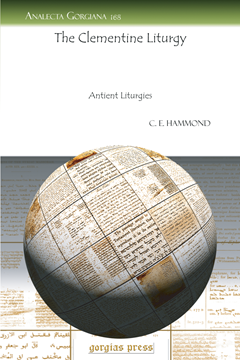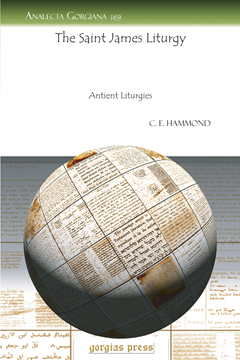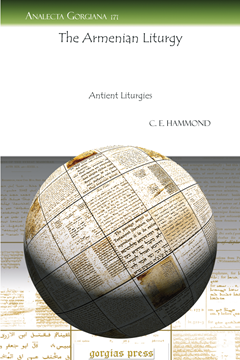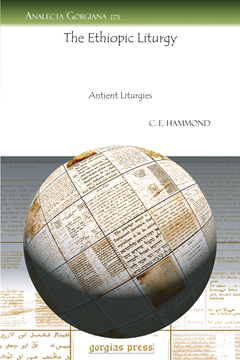The Clementine Liturgy
Antient Liturgies
Series: Analecta Gorgiana 168
ISBN: 978-1-60724-183-6
C. E. Hammond's Antient Liturgies provided a valuable resource at an early stage in comparative liturgical studies. Free of extensive critical apparatus, Antient Liturgies presents a collection of historic forms of worship from the Western, Eastern, and Oriental Churches. This extract from the book focuses on the Clementine Liturgy, an important early liturgy, apparently known even to Justin Martyr. Rendered in Greek and with an analytical introduction this early study continues to provide a broad overview of early Christian worship made available in an accessible and convenient format for students and scholars.
$37.00 (USD) $22.20 (USD)
The Saint James Liturgy
Antient Liturgies
Series: Analecta Gorgiana 169
ISBN: 978-1-60724-184-3
C. E. Hammond's Antient Liturgies provided a valuable resource at an early stage in comparative liturgical studies. Free of extensive critical apparatus, Antient Liturgies presents a collection of historic forms of worship from the Western, Eastern, and Oriental Churches. This extract from the book focuses on the St. James Liturgy, both the Greek and Syriac renditions. Representing the liturgy of the Patriarchate of Antioch, this liturgy is rendered in Greek and Latin. As an analytical introduction this early study continues to provide a broad overview of early Christian worship made available in an accessible and convenient format for students and scholars.
$45.00 (USD) $27.00 (USD)
The Liturgy of Constantinople
Antient Liturgies
Series: Analecta Gorgiana 170
ISBN: 978-1-60724-185-0
C. E. Hammond's Antient Liturgies provided a valuable resource at an early stage in comparative liturgical studies. Free of extensive critical apparatus, Antient Liturgies presents a collection of historic forms of worship from the Western, Eastern, and Oriental Churches. This extract from the book focuses on the Liturgy of Constantinople. As Hammond explains, this liturgy contains elements of the St. Basil, St. Chrysostom, and Presanctified liturgies presented in Greek. As an analytical introduction this early study continues to provide a broad overview of early Christian worship made available in an accessible and convenient format for students and scholars.
$43.00 (USD) $25.80 (USD)
The Armenian Liturgy
Antient Liturgies
Series: Analecta Gorgiana 171
ISBN: 978-1-60724-186-7
C. E. Hammond's Antient Liturgies provided a valuable resource at an early stage in comparative liturgical studies. Free of extensive critical apparatus, Antient Liturgies presents a collection of historic forms of worship from the Western, Eastern, and Oriental Churches. This extract from the book focuses on the Armenian liturgy. With a beginning in the early fourth century, in connection with the Exarchate of Caesarea, this liturgy is presented in English. As an analytical introduction this early study continues to provide a broad overview of early Christian worship made available in an accessible and convenient format for students and scholars.
$41.00 (USD) $24.60 (USD)
The Coptic Liturgy
Antient Liturgies
Series: Analecta Gorgiana 172
ISBN: 978-1-60724-187-4
C. E. Hammond's Antient Liturgies provided a valuable resource at an early stage in comparative liturgical studies. Free of extensive critical apparatus, Antient Liturgies presents a collection of historic forms of worship from the Western, Eastern, and Oriental Churches. This extract from the book focuses on the Coptic liturgy. The origin of the liturgy goes back to the St. Cyril and St. Basil liturgies. Here the liturgy is presented in Latin. As an analytical introduction this early study continues to provide a broad overview of early Christian worship made available in an accessible and convenient format for students and scholars.
$41.00 (USD) $24.60 (USD)
The Ethiopic Liturgy
Antient Liturgies
Series: Analecta Gorgiana 173
ISBN: 978-1-60724-188-1
C. E. Hammond's Antient Liturgies provided a valuable resource at an early stage in comparative liturgical studies. Free of extensive critical apparatus, Antient Liturgies presents a collection of historic forms of worship from the Western, Eastern, and Oriental Churches. This extract from the book focuses on the Ethiopic liturgy, here the liturgy is presented in Latin. As an analytical introduction this early study continues to provide a broad overview of early Christian worship made available in an accessible and convenient format for students and scholars.
$39.00 (USD) $23.40 (USD)





